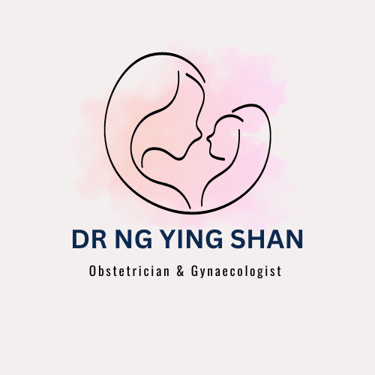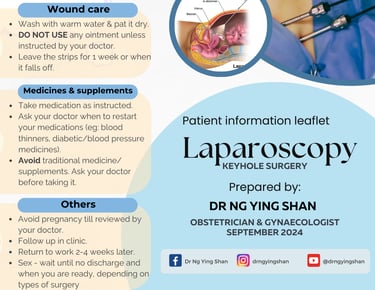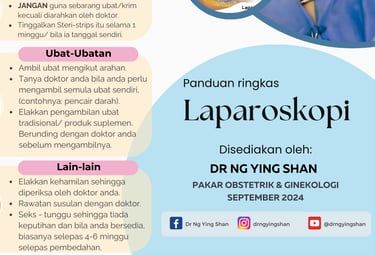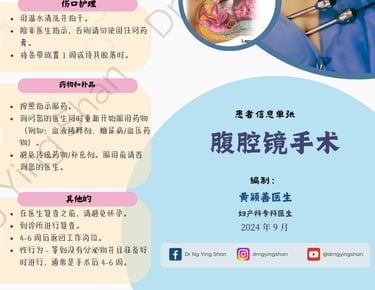
LAPAROSCOPY /
MINIMALLY INVASIVE SURGERY
腹腔镜手术 / 微创手术
LAPAROSCOPY KUCHING MINIMALLY INVASIVE SURGERY 古晋 腹腔镜手术 / 微创手术
Why laparoscopy?
Laparoscopy (Keyhole surgery) also known as minimally invasive surgery, is a preferred choice for many medical procedures due to its benefits.
This technique involves small incisions, thin tube with camera attached, small surgical tools and a small tube to pump gas into the tummy. It can be use to diagnose and treat various conditions. The advantages of this technique compared to traditional open surgery are:
reduced pain
smaller scar
faster recovery
shorter hospital stay
less risk of infection
less chance to have scar tissue formation inside tummy
Earlier return to full activites
magnified vision to help the doctor to see the surrounding blood vessles, nerves and other organs better

Frequently asked questions
What is laparoscopy?
Laparoscopy (Keyhole surgery) also known as minimally invasive surgery, is a surgical technique where doctor makes small inicision on tummy and uses thin tubes and camera to perform surgery.
What type of surgery can be done via laparoscopy?
Common gynaecological conditions that are suitable for laparoscopy surgery are (not limited to):
Ovarian cyst
Endometriosis
Ectopic pregnancy
Myomectomy (Removal of Fibroids)
Hysterectomy (removal of womb)
Female fertility related condition
How is the operation performed?
Laparoscopy is done under general anaesthesia. Around 1 to 4 tiny cuts (around 0.5cm - 1cm) will be made on the tummy.
The camera and thin tubes will pass through these small incisions and gas will be pumped into the tummy. Different tiny instruments are used via these small incisions to perform the surgery.
Number of incisions and size of incisions will be determined by the complexity of the case.
What are the benefits of laparoscopy (keyhole surgery) compare to laparotomy (open surgery)?
Laparoscopy surgery shows maginified vision to help doctor to see surrounding organs, blood vessels, nerves better. The benefits include:
Less pain
Less fever
Smaller scar
Faster recovery
Shorter hospital stay
Lower risk of adhesion (organ/tissue stick together)
There are few disadvantages of laparoscopy when compare to laparotomy. Laparoscopy requires more specialised surgical skills and equipments. In some cases such as huge / multiple fibroids, the laparoscopy surgery operating time may be longer than laparotomy. Besides, not all conditions are suitable for laparoscopy surgery.
What are the risk of laparoscopy?
Common risks:
Pain
Infection (wound, urine, chest)
Minor bleeding
Uncommon risks:
Damage to organs such as bladder or bowel
Major bleeding that required blood transfusion
Return to theatre
Pelvic abscess/infection
Blood clot in leg/lung
Convert to laparotomy (open surgery)
Others:
depending on type of surgery
Contact us
Our clinics runs on appointment basis. Feel free to call us to set up an appointment. We welcome walk-in patients on weekdays, but please be aware that there may be a wait time.
Phone:
+60 82-365 777 (ext: 266)
+6012 594 9938 (WhatsApp only)
Email:
drngysclinic@gmail.com
Clinic hours:
Monday - Friday: 9:00 AM - 4:30PM
Saturday : 9:00 AM - 12:30PM (appointment & alternate saturday only)
Sunday : close
Address:
Dr Ng Ying Shan,
KPJ Kuching Specialist Hospital,
Lot 18807, Block 11 Muara Tebas Land District, Jalan Stutong,
93350 Kuching, Sarawak
Disclaimer: The information provided in this website represents the views and opinions of the original creator. The information provided is intended for informational purposes only and is not intended to be a substitute for professional medical advice, diagnosis, or treatment. It's important to note that this website does not advocate for or endorse any specific tests, products, procedures, opinions, or information mentioned within its content. Always seek the advice of your physician or another qualified health provider for any questions you may have regarding a medical condition.
2024 All rights reserved © Dr Ng Ying Shan
免责声明:此网站提供的信息仅代表原始创作者的观点和意见。此网站提供的信息仅供参考,不旨在替代专业医学建议、诊断或治疗。此网站不主张或支持其内容中提及的任何特定测试、产品、程序、观点或信息。当您遇到任何健康问题时,请咨询您的医生或其他合格的医疗专业人员,,进行诊断与治疗。






